How do we tell where sounds are coming from? What does life sound like through a hearing aid? Can we cure tinnitus? We try to answer all these questions and more in our show on hearing.
In this episode

What can I do to alleviate my tinnitus?
Alan - Peyman, what could she perhaps do?
Peyman - Typically, when we lose one sense and in her case, she’s lost her sight, other senses then seem to become more sensitive. There are various things she can attempt as her hearing is normal. She probably won't be offered any hearing aids, but what people tend to do is use unconventional means or self-help techniques. People use different sounds for example, such as white noise, which works by drowning the tinnitus sound and this is called masking. There are also more pleasant sounds that people use which have psychological soothing effects like the sound of ocean waves, rainfall or soft music. But again, as with everything else to do with tinnitus, what works with one person doesn’t necessarily work with someone else.
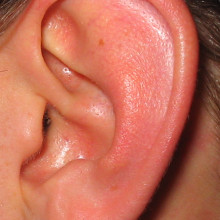
01:45 - How do we hear and what is hearing impairment?
How do we hear and what is hearing impairment?
with Owen Brimijoin, MRC Institute of Hearing Research, Glasgow
Chris - First up, how do we actually hear? What's happening in our ears and in our brains to give us a sense of sound and why are so many - in fact, 1 in 6 people in the UK - affected by problems with hearing? With us to discuss these issues is Dr. Owen Brimijoin from the MRC Institute of Hearing Research in Glasgow. Hello, Owen.
Owen - Hello, hello.
Chris - So, tell us a bit then about how the ear actually works. What is it doing?
 Owen - Right. Well, you have to consider that sound consists of these waves of pressure that are radiating outwards from any vibrating object. So you need a way to sense those changes in ear pressure over time. Deep inside our ears, inside a structure known as the cochlea, we have these little hair cells. We have ones that like to respond to low frequency sounds, slow vibrations, and we have ones that respond better to high frequency sounds, and entire range in-between. So, these little hair cells are dancing back and forth, and if you've got a complex sound like speech for example, it's vibrating in lots of different places at once. And the brain is paying attention to what parts of the cochlea are most active. And it's that pattern of activation across that allows you to detect your mother's voice and tell it from other people's voices.
Owen - Right. Well, you have to consider that sound consists of these waves of pressure that are radiating outwards from any vibrating object. So you need a way to sense those changes in ear pressure over time. Deep inside our ears, inside a structure known as the cochlea, we have these little hair cells. We have ones that like to respond to low frequency sounds, slow vibrations, and we have ones that respond better to high frequency sounds, and entire range in-between. So, these little hair cells are dancing back and forth, and if you've got a complex sound like speech for example, it's vibrating in lots of different places at once. And the brain is paying attention to what parts of the cochlea are most active. And it's that pattern of activation across that allows you to detect your mother's voice and tell it from other people's voices.
Chris - So the cochlea in the inner part of the ear is quite literally converting sound waves coming in from the outside world into brainwaves. It's producing neurological information that's fired off into the brain that we then decode with higher brain processing into speech and music, and that kind of thing.
Owen - Right and it's kept compartmentalised in the very beginning into low frequencies and high frequencies. And so, the brain already has a lot of its task accomplished.
Chris - So, when someone loses their hearing, what actually has gone wrong because people who complain of being hard of hearing often said they can hear some sounds, but not others.
Owen - Right. Well, one of the problems that the ear has is that the cochlea is full of fluid and as anyone has ever tried to shout at someone who's under the water, say, in a swimming pool, you know intuitively that sound doesn't like to travel from air into water. So, we have these structures where the eardrum and the middle ear bones whose purpose is to kind of convert these sound pressure changes so that they can effectively vibrate the fluids of the cochlea. Now that can go wrong. You can have earwax on your eardrum that prevents it from vibrating properly. Maybe you've got a middle ear infection and that prevents those little bones from vibrating properly. But most devastating and distressingly common the death or destruction of these little hair cells themselves and some of that is attributable to wear and tear, some to noise damage. There's any number of reasons why these die off and they don't come back. Once they're gone, they're gone. And so, the brain doesn't have any sensors in that area and can't detect those sounds.
Chris - So some sounds, you'll become less sensitive to because you've lost these hair cells in regions of the cochlea that correspond to those particular sound frequencies, but you could equally have other bits of the cochlea that would decode other sound frequencies that would be working normally. So you have gaps in your ability to hear certain types of sound.
Owen - That's right and if you think about it, these hair cells have been banging away back and forth in response to sounds, sometimes a thousand of times every second since you were born. So, it's perhaps no surprise that when people lose their hearing, it tends to be the high pitch sounds, the high frequency sounds that they lose first.
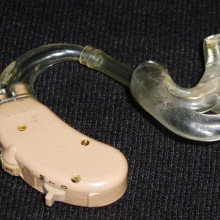
05:44 - How does a hearing aid work?
How does a hearing aid work?
with Søren Laugesen, Oticon Research Centre, Eriksholm, Denmark
Alan - And I think it's a good point to come in and start talking about how we restore hearing for hearing-impaired people, we'll come back to Owen in a second. And in my day-job, I'm a hearing aid researcher and so, I decided to talk about hearing aids and here is someone who has just been fitted with hearing aids, talking about why they wanted them.
Thelma - My name is Thelma Purchase and I live in Welwyn Garden City. What I really had the hearing aids for was that if I went to a talk then I could pick it up, but if I find that my family are here, and they're all talking together, and I miss what they're saying quite often.
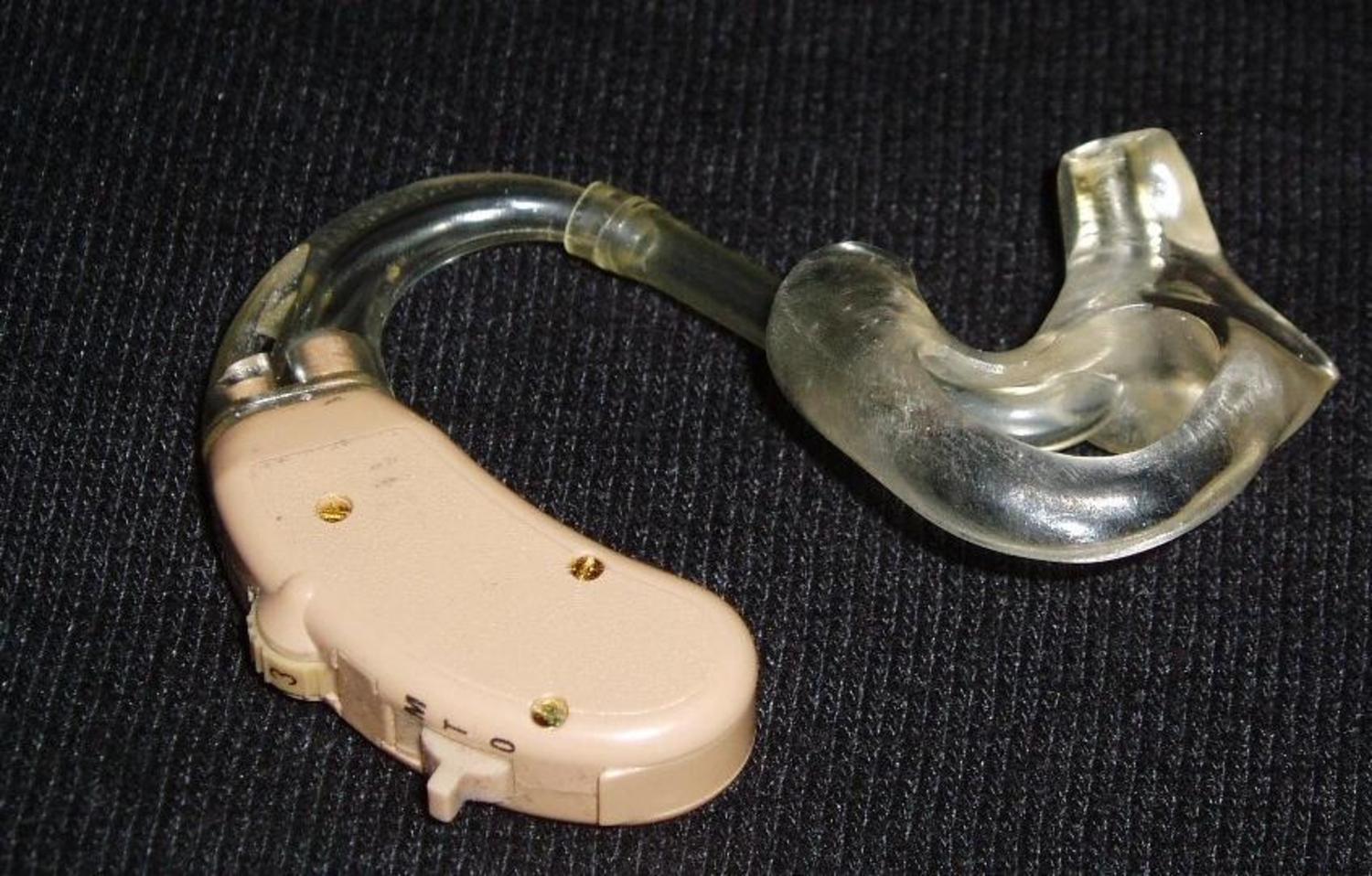 Alan - So how do hearing aids work and how could engineers improve them to give Mrs Purchase a better listening experience? I asked Soren Laugesen, a Research Engineer at the Eriksholm Research Centre, a part of the Oticon hearing aid company, what a hearing aid is.
Alan - So how do hearing aids work and how could engineers improve them to give Mrs Purchase a better listening experience? I asked Soren Laugesen, a Research Engineer at the Eriksholm Research Centre, a part of the Oticon hearing aid company, what a hearing aid is.
Søren - Basically, it consists of a microphone which picks up the sound so the digital circuitry that processes this sound and a small loudspeaker that delivers the sound back to the ear.
Alan - So, is a hearing aid basically a pair of glasses for your ears?
Søren - The most obvious thing you notice about people with hearing loss is that they can't hear the very soft sounds. A big part of what a hearing aid does is to amplify sounds to make these soft sounds loud enough to be heard by the user. But it's not as simple as that because if you try out a loud sound, you'll actually recognise that a hearing aid or a hearing impaired person hears this sound perfectly well. So, the hearing aid doesn't need to amplify the loud sounds, only the soft sounds. And in order to do that, we have some circuitry, which is called a compressor, which makes sure that the soft sounds are amplified but keeps strong sounds basically where they are.
Alan - To give you an idea of what this sounds like, here's an uncompressed sentence...
"Hello. I'm speaking quite quietly at the moment. But sometimes I raise the level of my voice..."
I just amplified the whole thing, the quiet bit would indeed be easier to hear, but the loud part would become painfully loud. Instead, the compressor circuit in the hearing aid makes the quiet bits louder, but leaves loud sounds untouched so the overall sound is a consistent volume.
"Hello. I'm speaking quite quietly at the moment. But sometimes I raise the level of my voice"
...but what if there's background noise? How can we help a hearing impaired person listen to one sound among many? For instance, I'm now sitting in a busy café using a microphone that picks up all the sound around you. The overall sound you're hearing is loud enough, but my voice is not very clear due to all the background noise. How can we alleviate this problem?
Søren - In order to improve on that, we put various helping systems into the hearing aid and the most powerful is definitely the directional microphone. Can you imagine that if you have 2 microphones in a line and that sound is coming straight behind you then you'll have the same sound picked up by the 2 microphones with a little bit of tiny delay between them. So if you now take the 2 signals and delay them with respect to each other and subtract them from each other, you'll end up with nothing. So, the microphone will pick up nothing from behind, but will still be able to pick sound up from the front direction where you want to hear from.
Alan - And so, if we now switch the microphone to direct mode, you should be able to hear me more clearly because the background noise is not being picked up by the microphone. But what about the noise that's left, such as low frequency sounds?
Søren - The other form of noise reduction that we have in a hearing aid, is a mechanism that looks at the sound that is coming into the hearing aid and tries to figure out whether certain bits of it is actually noise or actually a signal that the user wants to listen to. And if you have noise let's say, at very low frequencies, then you can turn down these low frequencies where the noise is dominating, in order to allow speech that you want to listen to, to come through more clear in the other frequency bands.
Alan - So that's how we remove unwanted background noise, but why is the sound quality from a hearing aid...which sounds a little like this, not as good as a CD player for instance?
Søren - In a CD player, there's a sounding rate of what we call 44,100 Hertz which essentially means that the system is measuring the actual sound 44,000 times each second, but that has a cost in terms of processing power and the simple electrical power you need to feed into the system. And we can't really afford that in the hearing aid because the battery is so small. So, a typical modern hearing aid will operate at a sampling rate of a little less than half of the CD player, which means that we have to say goodbye to the upper part of the frequency range. But what really makes a difference to the sound quality you can get from a hi-fi system and hearing aid is the loudspeaker that we're using, which for obvious reason has to be very, very tiny. So there's really a limit to how loud it can play and also again, the bandwidth of what it will be able to produce.
Alan - So the smaller loud speaker and the reduced number of samples of sound taken each second by the hearing aid reduces the higher frequencies in the sound, and produces a lower sound quality. We can also improve hearing aids by having them communicate information with each other about the sounds coming in to each of them. The difference in volume between your ears is one way of discerning where sound is coming from. By having the hearing aids communicate, we can preserve this difference, even when amplifying and compressing sounds.
Søren - In some situations, it can create some problems if the amount of amplification on the 2 are different. To avoid that problem, we could coordinate the 2 hearing aids to that they act in synchrony.
Chris - Soren Laugesen, explaining the workings of a hearing aid to Alan Boyd. Alan, so you actually work on this. So, that was really interesting, what he was saying about the linking together of the 2 hearing aids in the right and left ear so they literally talk to each other. Is that actually being implemented yet or is that still experimental?
Alan - The implementation of that is actually available on the market at the moment, but largely just for what's called changing programme. So just pressing buttons, you don't have press 2 buttons on either side. But the actual linking in terms of sound information is coming in and is a kind of cutting-edge part of the research.
Chris - So listen up for that one. It's coming to a hearing aid near you quite soon.
How does an unborn baby hear?
Chris - Joanne is in Lincolnshire and she's with us. Hello, Joanne.
Joanne - Hello.
Chris - Your question.
Joanne - How does an unborn baby hear because they definitely react to different sounds?
Chris - Absolutely true, yes, they do and a lot of research has been done on this actually including a very nice study that was done by scientists in America about 10 years ago now. They were interested in the amount of sound that pregnant women may experience in the military because with increasing numbers of women taking part in armed services work, they wanted to be sure that there wasn't a potential danger to an unborn child, so they did experiments where they took a sheep that was pregnant and they put in a microphone inside the sheep's uterus, in the ear of the developing lamb and they recorded sounds from there and also, outside the sheep. And they made recordings of sounds played at the sheep with a loud speaker and then asked a group of volunteers to listen back to what they'd recorded. And they found that about 1/3 to Ã?,½ of the recordings were perfectly intelligible when the volunteers listen to them. They could repeat back the words that have been played out of the speaker. The reason for that is that sound waves, just as Owen was explaining a compression wave, they vibrate things and fluid conveys sound waves extremely efficiently. And so, the vibrations will hit the side of the sheep or the human. They then go through the muscles in the skin and they then hit the uterus, which is the womb and then make the fluid inside it vibrate and those vibrations can be carried to the ears of whatever is developing inside. So, a baby is literally listening to its mum's voice and other studies have shown that when babies pop out, they are born, tuned to their mother's voice and they even imitate her accent regionally when they cry. And this was proven a couple of years ago, comparing babies born to German and French mothers, and the cries had a very different pattern which was similar to the way that you speak those 2 different languages. But a lovely question. Thank you for joining us with it.
Joanne - Thank you.

14:14 - How do we tell where sounds are coming from?
How do we tell where sounds are coming from?
with Owen Brimijoin, MRC Institute of Hearing Research, Glasgow
Chris - Pleasure. Let's go back to Owen because Owen, one of the things that was mentioned when Alan was talking to Soren about hearing aids was this whole concept of binaural hearing, how you compare what the right or left side of the brain is getting from each ear. You work on this. How important is this for us when we're just going about our daily business?
 Owen - It's very important because it's actually one of the few rock solid cues that you have to determine where a sound is coming from. There are 3 basic ways you can do it, 2 of them do involve comparing the information at the 2 ears. If you have a sound say, on your right, it will be louder in your right ear, and it will be quieter in your left ear in a small part because it's further away, but mostly because the head is in the way, it creates an acoustic shadow, its said. And then similarly, it takes longer, it takes longer time for the sound to pass to the further ear and the brain is exquisitely sensitive to these subtle differences in timing. At the greatest, they're really only about a half a millisecond.
Owen - It's very important because it's actually one of the few rock solid cues that you have to determine where a sound is coming from. There are 3 basic ways you can do it, 2 of them do involve comparing the information at the 2 ears. If you have a sound say, on your right, it will be louder in your right ear, and it will be quieter in your left ear in a small part because it's further away, but mostly because the head is in the way, it creates an acoustic shadow, its said. And then similarly, it takes longer, it takes longer time for the sound to pass to the further ear and the brain is exquisitely sensitive to these subtle differences in timing. At the greatest, they're really only about a half a millisecond.
Chris - Jonathan Manning has got in touch with a lovely question. It made me laugh, but then think. So maybe he deserves some Ig Nobel nomination for this. He says, "Can people with massive heads locate sounds better or more quickly than people with smaller heads?"
Owen - Right, yes. I'd have to say - I've never seen a study entitled, "Sound localisation ability as a function of head size" but I have to say, yes so if your sensors are further apart, then the cues will be larger. They'd be exaggerated.
Chris - What about front to back?
Owen - Right, that's where the 3rd cue comes in, the spectral shaping properties of your ear. Everyone's got different folds and different ridges in their outer ears and sounds coming from different directions kind of bounce off it in different ways and essentially, give it a different timbre. Just as you could tell the difference between an oboe and a violin playing the same note, so too can you tell the difference between the sound that's ahead, and behind because it just sounds different. That's a way to kind of get around that problem that sound in front arrives at the 2 ears at the same time, but it also arrives at the ears at the same time if it's directly behind.
Can people with massive heads locate sounds better than people with smaller heads?
Owen - Right, yes. I'd have to say - I've never seen a study entitled, "Sound localisation ability as a function of head size" but I have to say, yes so if your sensors are further apart, then the cues will be larger. They'd be exaggerated.

16:47 - Eczema treatment target identified
Eczema treatment target identified
A potential new target for the treatment of eczema has been found by researchers at Boston Children's Care Hospital.
Fifteen per cent of children suffer from eczema, or atopic dermatitis, a debilitating and potentially disfiguring skin condition.
 In the condition, immune T cells, a type of white blood cell, invade the skin and secrete substances that produce an allergic response and itchy skin.
In the condition, immune T cells, a type of white blood cell, invade the skin and secrete substances that produce an allergic response and itchy skin.
The scientists showed that scratching the itchy skin increases the severity of the condition by encouraging an influx of other immune cells called neutrophils.
The neutrophils secrete a fat, or lipid molecule called leukotriene B4, that attracts more neutrophils and the potent T cells.
These cells aggravate the skin further by causing skin inflammation. By blocking these cells from entering the affected area, the disease can be slowed down or even stopped entirely.
Previous to this study, published in October's Immunity, a Cell publication, little was known about the role of leukotriene B4, but scientists suspected that its production was recruiting T cells to the scratch site.
Using a mouse model of eczema, the team used a drug that blocked the leukotriene B4 and this was found to block the development of an allergic skin inflammation. In addition, they found that deleting the receptors for leukotriene B4 on the immune cells themselves had a similar effect.
These findings suggest that the neutrophils that secrete the leukotriene B4 play a key role in skin inflammation and that a new therapy for Excema could be developed, targeting the production of or response to, these cells.
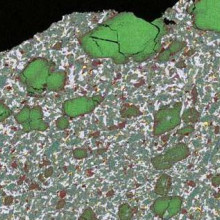
19:00 - Meteorite brings Mars atmosphere to Earth
Meteorite brings Mars atmosphere to Earth
A meteorite that fell to Earth in 2011 contains trapped samples of the Martian surface, interior and atmosphere.
Tissint, as the rock is known, landed in Morocco on the 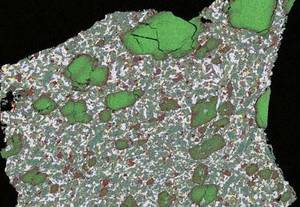 18th July last year. Unlike previous Martian meteorites, this one was watched as it fell and was recovered quickly for analysis before it could be significantly contaminated by material from Earth.
18th July last year. Unlike previous Martian meteorites, this one was watched as it fell and was recovered quickly for analysis before it could be significantly contaminated by material from Earth.
Now scientists have published the first analyses of the material, concluding that Tissint contains material from Mars' surface, bubbles that are almost certainly filled with gas from the Martian atmosphere, and lumps of igneous rock erupted at some earlier time from the red planet's interior.
Writing in Science, Hassan II University Casablanca scientist Hasnaa Chennaoui Aoudjehane and her colleagues describe how the meteorite contains a glassy material within which is trapped these vestiges of the past on Mars.
The bubbles contain an excess of a certain isotope of nitrogen, which agrees exactly with data collected about the Mars atmosphere by the Viking probes in the 1970s.
The trapped surface material also seems to contain organic matter which the team disclosed by heating tiny fragments of the meteorite, and the presence of sulphur seems to suggest that the surface material was weathered for a time before it was ejected into space.
The researchers were also able to show, by looking for radioactive particles embedded into the rock's surface by the solar wind, that Tissint had been circling in space for about 750,000 years before it landed here.
According to Chennaoui Aoudjehane, the findings paint a picture of a rock that started life as an erupted basalt on the surface of Mars; it was weathered for a time by fluids that imparted to it elements from the planet's surface, including sulphates, which were deposited in fissures and cracks on the surface.
A subsequent impact, from outer space, caused the rock to partly melt, locking the surface material and bubbles of atmospheric gases inside. Ejected into space, the rock has been wandering aimlessly for three quarter of a million years until it crossed our path in 2011...
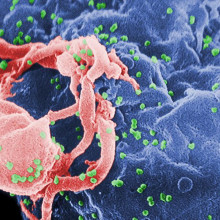
21:40 - Gut viruses trigger AIDS
Gut viruses trigger AIDS
A host of previously-unknown gut viruses contribute to the onset of AIDS, new research has revealed.
In both monkeys and humans, damage to the gastrointestinal tract is common and this contributes to activation of the immune system, progressive immune deficiency and ultimately advanced AIDS.
Previously it was not known how this damage occurred. Now researchers at the Harvard Medical Centre at the Beth Israel Deaconess Medical centre in Boston may have found the source.
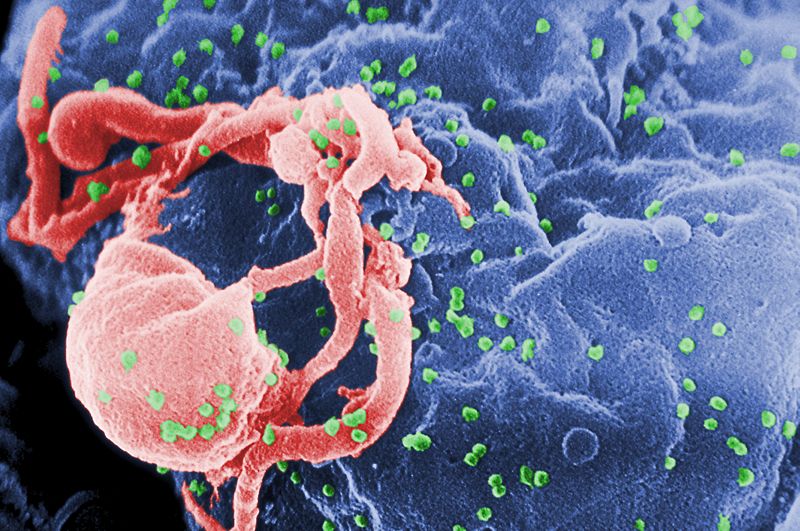 The researchers used a gene sequencing method to obtain genetic sequences for everything in the gastrointestinal tract, from bacteria to viruses and other organisms.
The researchers used a gene sequencing method to obtain genetic sequences for everything in the gastrointestinal tract, from bacteria to viruses and other organisms.
Compared with healthy monkeys, the faeces of monkeys with SIV-induced AIDS (SIV is the monkey equivalent of HIV), contained a large number of previously undescribed viruses.
These, the scientists suspect, may be contributing to the progression of AIDS in monkeys.
Their compromised immune systems, the team speculate, might increase the prevalence of the viruses to start with.
This, in turn, leads to greater damage to the wall of the intestine, allowing other potential pathogens and inflammatory material to enter the bloodstream where it stimulates the immune system. Paradoxically, this also has the side-effect of promoting the replication of SIV, causing accelerated loss of immune cells and accelerating the rate at which AIDS, when the immune system finally fails, sets in.
The work was published in
Cell.
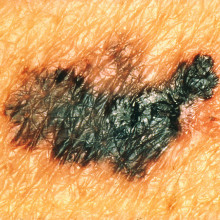
24:17 - Melanoma dodges immune attack
Melanoma dodges immune attack
Melanoma skin cancers dodge immune attack by adopting a chemical disguise, new research has revealed.
In recent years, doctors have made significant 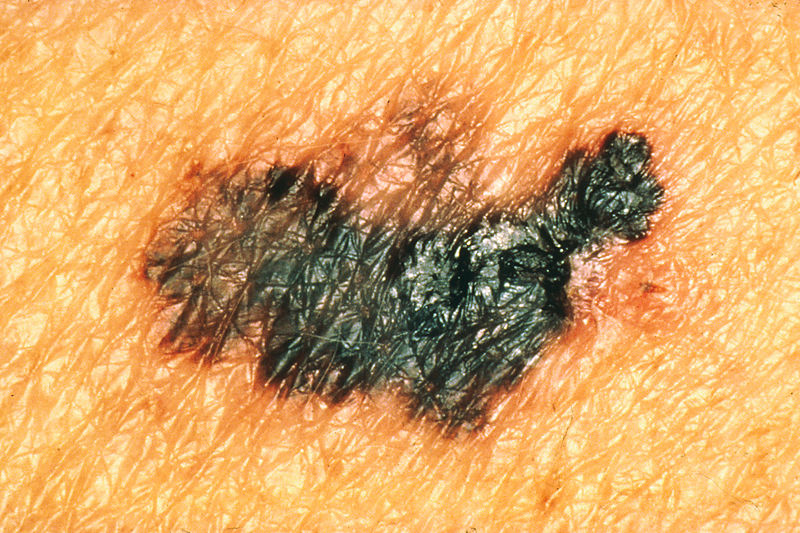 progress in cancer treatment by triggering the immune system to attack tumours. But these strategies, while often successful in the short term, are often blighted by relapse and the later return of the cancer.
progress in cancer treatment by triggering the immune system to attack tumours. But these strategies, while often successful in the short term, are often blighted by relapse and the later return of the cancer.
Previously, this had been put down to the survival of a sub-population of malignant cells within a cancer that, by chance, were invulnerable to the therapy and could subsequently re-kindle the disease.
But now new research carried out by University of Bonn scientist Jennifer Landsberg and her colleagues suggest that something altogether more cunning is taking place. Using animals with the mouse equivalent of melanoma, the German team administered immune cells pre-programmed to attack the tumours.
Initially, the immune response was very successful, removing visible tumours from the animals. But just like in humans receiving these sorts of treatments, the animals usually later relapsed.
Careful examination of the tissues, however, showed that, in response to the immune attack, some of the cells in the tumour were switching off the very chemical markers that singled them out to be cancerous, rendering them invisible to the immune response.
This was enabling them to dodge the targeted immune therapy. When the onslaught was over, however, the cells re-upregulated their original markers and re-established the disease.
The cause, the team found, is a signalling chemical called TNF-alpha, which is used by the immune system to control its attack. By tuning into this signal and then chemically "ducking" by deactivating the very markers the immune system was looking for, the persistent tumour cells were able to escape.
Intriguingly, human melanoma cells also respond in the same way, the scientists show in their paper, published in Nature.
This suggests that immuno-therapy, as this field is known, needs to take these responses into account and, when engineering anti-cancer treatments, scientists need to programme the immune system against additional markers so that cells can't so easily disguise themselves in future...
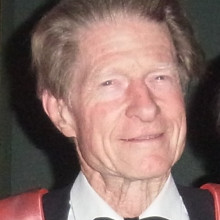
26:48 - John Gurdon, 2012 Nobel prize winner in Physiology and Medicine
John Gurdon, 2012 Nobel prize winner in Physiology and Medicine
with John Gurdon,
Now also this week, big news for Cambridge University, we won another Nobel Prize. Well not we, personally - someone who works at the Gurdon Institute. In fact, it is Embryologist Sir John Gurdon. He learned on Monday that the Physiology and Medicine Nobel award had come his way and it was in recognition of his discovery using frogs, that if the DNA and the nucleus are specialised cells from say the intestine or the skin of an adult, is then put into an egg cell, which had its own genetic material removed, you can get a new frog which is genetically identical to the first one. This is of course, the basis of the cloning process which eventually enabled scientists in the '90s to clone Dolly the sheep. At the age of almost 80, Sir John Gurdon is still doing experiments and I went to see him in his lab this week to find out how he made this dramatic breakthrough.
 John - The story leading to this award - well of course, that goes back right to almost the beginning of life. My mother and aunt could see I - at a very early age like 6 or 7 - I liked to catch butterflies and they encouraged that. That encouragement went on during my teenage years when I was at school and I used to infuriate my housemaster's school by growing caterpillars as much as I could in my room, which he thought was a waste of time and stupid.
John - The story leading to this award - well of course, that goes back right to almost the beginning of life. My mother and aunt could see I - at a very early age like 6 or 7 - I liked to catch butterflies and they encouraged that. That encouragement went on during my teenage years when I was at school and I used to infuriate my housemaster's school by growing caterpillars as much as I could in my room, which he thought was a waste of time and stupid.
Chris - How did that turn into the work that then lead to you winning the Nobel Prize?
John - I was started on science at school at the age of 15. In those days, we didn't do any science until you were at that age. And then I did one term of science being taught by a biology master and he gave me an absolutely crippling report, essentially saying I was absolutely unsuited to science, at which point in time was removed from science in the rest of my time at school, and was put on to ancient Greek and Latin. And then when I finished school, my mother and family could see what I really was interested in was actually biology in one form or another. And they, having paid very expensive private school fees until the age of 18, they were then asked if they would spend another 2 years, having me trained to get into science, which they very generously did and then I ended up being accepted for the zoology course in Oxford University. And then the career really took off when I was a graduate student with a wonderful supervisor in that department.
Chris - So, how did you then translate with that into an interest in the work that then lead to where you are now?
John - Well, when I needed to start a PhD, the person who kindly invited me to become a student of his, he was an embryologist and I did think that was an extremely interesting subject, as to how a plant seed turns into a plant, or an egg turns into an animal with no guidance from outside, particularly if you think of frogs, that egg just sits there in a pond and somehow it knows on its own, how to turn into a tadpole, amazing phenomenon. So, I was delighted to be accepted for a PhD work in what was called embryology.
Chris - And how did you progress that? What were the big questions when you started your PhD?
John - That's a really good point. The primary question I was concerned with was whether all the different cell types of the body have the same sets of genes or not, and one has to go back a step and remember that in the late 1800s, people were very curious about whether the formation of different cells meant that something is lost from the cells that don't need it. For example, brain genes being lost from skin or heart genes being lost from the liver, or if not lost, at least permanently put out of action.
Chris - So people thought that when a cell turns fro say, a primitive cell in an egg into what becomes skin that in becoming skin, it in some way throws away some of the genes that would enable it to do anything else. So, for the rest of its life, it has to stay as a skin cell.
John - That's exactly right and there's a person whose name was August Wiseman who actually proposed that that is how development works. It would make good sense really that you throw what you don't want, and you end up keeping what is needed for the particular cell type you are trying to make.
Chris - Seems pretty logical to not keep stuff. So you were very much swimming against the tide. If you were trying to disprove that, you're going a completely different the opposite direction to what people thought at that time.
John - In a way, it was swimming against the tide, but really, the point was - this was a question being asked. It wasn't as if they said, "We know this happens. You have to kind of prove it." It was thet saying, "Is that how development works?" and there is a piece of background that's important. The technique of introducing a nucleus from a cell into an egg was actually invented by 2 Americans called Briggs and King. And they did that in 1952 and they found that if you take the nucleus of a very early embryo cell and put it into an egg whose own genes have been removed, they did indeed get normal-looking tadpoles. However, they found that if they took a nucleus from a little bit later embryo, an embryo at a day later, that no longer happened. And so, they concluded, as indeed I would have done if I have done that experiment, that something is being lost or permanently inactivated that is needed to enable the whole organism to be formed. So, I was in the position of being invited by my supervisor to try and do the same work, albeit on different species.
Chris - How did you actually do that and how many embryos did you have to throw away before you realised what was actually going on?
John - So, the Briggs and King had invented this clever method and we tried that and it absolutely wouldn't work at all. So, that turned out to be because the kind of frog we were using has an extraordinary elastic jelly coat, which makes it totally impenetrable. By a piece of luck, my boss had recently bought a fancy ultraviolet microscope for UV microscopy and an extraordinary piece of luck was that that particular wavelength of ultraviolet light also destroyed this jelly coat, meaning it was possible to actually penetrate this egg with a micropipette. Sometimes it works absolutely perfectly and the combination of the transplanted nucleus and egg will make a completely normal adult frog. Other times, it doesn't something goes wrong and the more advanced the cell from which you take the nucleus, the more likely it is to go wrong, but it works from time to time.
Chris - So, that led you to be able to conclude that regardless of how specialised a cell is, there is a complete compliment of DNA in that cell which if you put it back into an egg can recapitulate an entire animal again. So you get that result, your whole life changes presumably because you have suddenly rewritten biology.
John - Yes, it did really because it seem to prove that - we now believe it to be true - that all cells of the body, almost all have the same set of genes, and from then onwards which was roughly 50 years ago, I've been trying to discover how that happens, what has the egg got that can set the whole programme back to the beginning again. And some people say, "Gurdon did an interesting experiment when he was a student and he spent the next 50 years doing nothing useful at all."
Chris - do you agree?
John - I like to think not because we actually do understand a reasonable amount, don't understand everything. That's my next aim, to try and fully understand how this is done.
Chris - John Gurdon who won the 2012 Nobel Prize for Physiology in Medicine chatting with me early this week, and I've put a full version of that interview in which he talks about what he's doing today as a special edition Naked Scientists podcast on our website. If you go thenakedscientists.com and follow the links to our special podcasts, you will find that there.

35:15 - Planet Earth: Future-proofing
Planet Earth: Future-proofing
with Karsten Schönrogge, Centre for Ecology and Hydrology, Wallingford
Alan - Forests cover almost 1/3 of the Earth's landmass and play a key role in the health of our planet. They regulate climate change by removing carbon dioxide from the atmosphere through photosynthesis and storing the carbon. Planet Earth podcast presenter Sue Nelson meets Dr. Karsten Schönrogge from the Centre for Ecology and Hydrology in Wallingford. And she began by asking about the meaning of a current buzzword with regards to climate: future proofing.
 Karsten - Well, we're talking about particularly commercial forestry where foresters are concerned with the fact that plantations they put down into the ground today have a turn over time from 50 years, 80 years, sometimes 100 years and so the trees that they are planting now will experience the climate which we expect to be here in 1,500 years. So, the question is whether current planting strategies to source the seed material locally is actually the best strategy there is. Future proofing might mean to go to areas where the range of the plant they are interested in which today experience a climate which we expect here in the future.
Karsten - Well, we're talking about particularly commercial forestry where foresters are concerned with the fact that plantations they put down into the ground today have a turn over time from 50 years, 80 years, sometimes 100 years and so the trees that they are planting now will experience the climate which we expect to be here in 1,500 years. So, the question is whether current planting strategies to source the seed material locally is actually the best strategy there is. Future proofing might mean to go to areas where the range of the plant they are interested in which today experience a climate which we expect here in the future.
Sue Nelson - When I think of forests I think of spruce and pine and the sort of forests you might get in Germany, for example. What sort of forests are you, in particular, thinking of - what sort of trees?
Karsten - Our project is particularly aimed at sessile oak trees which is one of the two native species which we also have here in Britain. These are hardwood trees and there is a particularly interest to grow these trees for the timber industry; it was also THE tree in Europe which supports the highest biodiversity. On oak trees we would find across Europe possibly 700 different species of insects which is by far more than any other tree species that we have.
Sue Nelson - Now why can concern yourselves with insects, for example, when you think of the amount of carbon stored by trees that if the forests are removed then surely it is more worrying about the amount of carbon that is released into the atmosphere rather than, say, an insect species go extinct.
Karsten - Forests are, of course, not an isolated system by itself and insects in forests might be pest insects and actually damage the function that we want or there might be predators of pest insects and therefore it would be beneficial to ecosystem services which we might want to promote.
Sue Nelson - So how do you go about future proofing in terms of an experimental way? How do you determine whether oak trees will be able to withstand a change in climate?
Karsten - On our project we were inspired by a particular strategy which was published in the literature called climate matching and in climate matching scenarios we used forecasts for climates to be expected in the UK in 50 or 80 years and we look for areas across Europe where that climate already exists.
Sue - Okay, so what will the UK be like in 40 or 50 years? Which climate does it most match?
Karsten - It will depend on whether the carbon dioxide output will increase with no further limitations or whether we have a low CO2 scenario but the matching areas for, for instance, southern England, the Bordeaux area in France and a low carbon dioxide scenario but central Italy for a high CO2 scenario.
Sue - That's quite a difference.
Karsten - It's quite a difference and we expect those trees to perform well in 50 to 80 years but of course as they go in the ground now we might expect them not doing very well.
Sue - So you've planted some oak trees then in a specific area in northern France, what are you actually looking at then in terms of determining whether the oak trees are doing well or not?
Karsten - The trees were planted by collaborators of ours in France - an organisation called INRA - it's the largest trial of its kind. It's a million trees in four locations and we work in one of them, so 250,000 of them and we looked at trees which come from 20 different locations in Europe as far away as Ireland and the west, Denmark in the north and Georgia and Turkey in the south. Our colleagues at INRA look at every single tree and scored them for the time of the year when they come into leaf, they scored them for the growth, for the form they grow in, how many branches they have.
Sue - What did you find?
Karsten - So our first interest was whether these trees are locally adapted to the climates in the area where the seeds came from and there's strong evidence that these trees differ according to the place where they come from. So second then was whether we can take the phenotypes of all the different rose parameters and the time when they come into bud and to leaf would determine the insect communities which are associated with them, and that seems to be true as well, in fact we can take a step out, we can take the climate variables from the places where these seeds came from and we can predict how different these insect communities might be. The more complicated part of all this is to predict exactly how the communities differ and too possibly make a prediction about actual species of insects and whether they might become more or less abundant when they are feeding on these foreign povenors as we call them, oak trees.
Sue Nelson - So who is going to be most interested in the result of your research?
Karsten - Well we hope that both the forestry community who makes plans as to who what good planting strategies are would be interested but also the conservation areas of the biodiversity sector in general.
Sue - So better forest management will come out of this in order to effectively protect future forests - future proofing - there's that word, future proofing.
Karsten - Absolutely.
Alan - Dr. Karsten Schönrogge from the Centre for Ecology and Hydrology in Wallingford. And you can hear a longer version of that interview on the current edition of the Planet Earth podcast. Simply follow a link from our webpage or find it via Planet Earth online.

40:32 - Mobiles Track Malaria and Mice Learn New Squeaks
Mobiles Track Malaria and Mice Learn New Squeaks
with Caroline Buckee, Harvard School of Public Health; Matthias Maercker, University of Bonn; Gregor Warnecke, Hanover Medical School; Erich Jarvis, Duke University Medical School;
Tracking Malaria with Mobile Phones
 For the first time, anonymous mobile phone data has been used to discover how human travel patterns contribute to the spread of malaria. The same model could be also be used to track diseases like influenza.
For the first time, anonymous mobile phone data has been used to discover how human travel patterns contribute to the spread of malaria. The same model could be also be used to track diseases like influenza.
Researchers at the Harvard School of Public Health,
publishing in
Science, mapped the locations of calls and texts from 15 million mobile phones in Kenya over a 12 month period.
This information was combined with data charting cases of malaria, enabling the team to identify factors that contribute to outbreaks such as, for instance, journeys to high-risk outback areas. Co-author Caroline Buckee explains how she will build on this work...
Dust Spirals Shed Light on Stellar Evolution
New features of stellar evolution have been observed by astronomers at the University of Bonn, using the ALMA Array telescope in Chile.
The radio telescope is made up of many smaller telescopes working together, giving vastly more detailed images of stellar objects than previously available. Using the telescope, the researchers were able to study the outer shell of dust and gas a star throws off in its later life, during a so-called 'thermal pulse'. The team unexpectedly found a spiral structure of dust and gas connecting the star to its shell, which allowed the team to find far out more about how the star behaved before, during and after the creation of the outer shell than they previously expected.
Matthias Maercker, a co-author of the paper published in Nature explained the importance of this work.
Matthias - Thermal pulses are really a main driver of the evolution of old stars. They really drive the creation of new elements inside the stars, so it leads to the chemical evolution of the star itself and all this material eventually gets put into the stellar wind and blown into space. Most of the elements that we see on Earth for example, especially the ones that are lighter than iron, all the carbon, all the oxygen comes from stars like this. So, understanding this process is basically understanding how life is formed in the universe.
Keeping Lungs Alive
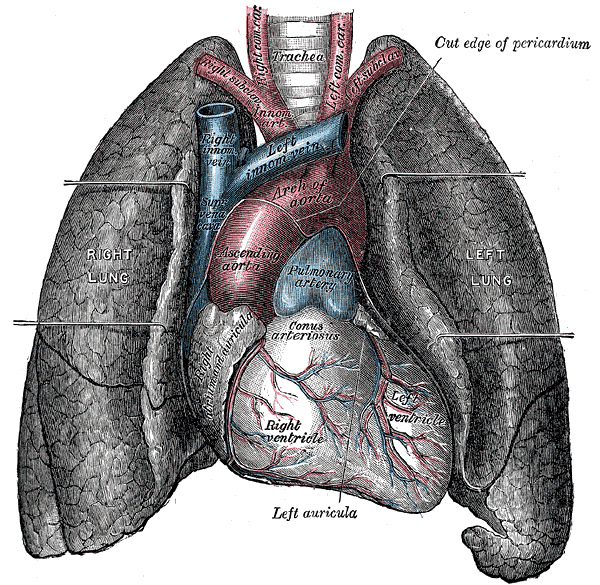 Medical engineers have designed a device that can not only keep donor lungs alive for longer, outside of the donor's body, but also enable more thorough checks and even some improvement for partially damaged lungs for transplant.
Medical engineers have designed a device that can not only keep donor lungs alive for longer, outside of the donor's body, but also enable more thorough checks and even some improvement for partially damaged lungs for transplant.
Normally, lungs are transported at a cold temperature to slow down the effects of metabolism and oxygen starvation outside the body. This new system puts, or perfuses, a blood-like solution through the lungs, at body-temperature to keep the lungs viable for 10 hours, several hours longer than previous systems.
Gregor Warnecke, a co-author of the Lancet paper and a member of one of the several German institutions involved in the study described the device's potential for longer term storage in laboratory trials...
Gregor - We have perfused these organs for 24 hours and in some occasions, even for up to 72 hours and still, having stable function after that time.
Male Mice Mimick Squeaks
And finally, it was thought that mice lack the ability to learn new vocalisations, or to put it more simply, learn a new squeak. That is, until now. Work published this week in PLoS ONE by researchers at the Duke University Medical Centre, have found parts of the brain in mice that controls copying a sound, a behaviour thought to be unique to humans and songbirds. The researchers found that male mice could learn to match vocal pitch of another mouse, mimicking its squeak. The co-author Erich Jarvis explains why...
Erich - They sing these songs to the females. It's probably a courtship display, meaning that they're trying to attract the female for mating. So, if one guy is getting the female more often than the other, what he might try to do is match that pitch of that guy's song. This study shows that we could use mice as a model to find out more about speech disorders affected by vocalisation, such as Autism.

45:09 - Tinnitus: What causes it and how can it be cured?
Tinnitus: What causes it and how can it be cured?
with Peyman Adjamian, MRC Institute of Hearing Research, Nottingham
Alan - Tinnitus is the experience of sound in the absence of any real noise and it's estimated to affect 1 person in 5 and can have a devastating effect on some people's lives.
Thelma - My tinnitus, I have two pulses and I have one that go boom, boom, boom and the other one goes whoom, whoom, whoom, slightly higher, bit crazy. It causes me to panic at times. During the day, it's fine because I have plenty of noise around me, but I find it mainly at night.
![Tinnitus (c) [http://flickr.com/people/17642817@N00 Jason Rogers]</p><p> Tinnitus](/sites/default/files/media/Tinnitus.jpg) Alan - Dr. Peyman Adjamian researches tinnitus at the MRC Institute of Hearing Research in Nottingham. So Peyman, what exactly causes tinnitus?
Alan - Dr. Peyman Adjamian researches tinnitus at the MRC Institute of Hearing Research in Nottingham. So Peyman, what exactly causes tinnitus?
Peyman - Well actually, that is the 6-million dollar question. The exact cause of tinnitus is I'm afraid, unknown. The fact is, there is no single cause. Very often, what is known are associated events. So for example, people will say their tinnitus started when they heard a sudden loud noise or when they had earwax removed, or when they had a bad bout of flu, or an ear infection. But in many cases, it just seems to appear from nowhere.
Alan - So, how many people are actually affected by tinnitus?
Peyman - Well, estimates tend to vary and the main reason for that is many people with tinnitus simply aren't bothered by it, so they tend not to report it or they tend not to seek help. But in most studies, the prevalence is about 20% of the population and in about 10% of these, it can seriously affect the quality of their lives.
Alan - And so, who is most likely to suffer from tinnitus?
Peyman - In theory, anyone can develop tinnitus. It's most common however in people with hearing loss. And if I may expand on that a little, in the cochlea, sounds of different frequency are processed in order from high to low frequencies, and we think what happens is that in tinnitus', there are some hair cells that get damaged and the cochlea no longer transmits sounds to the brain that correspond to those frequencies. So, neurons further up in the auditory system begin to produce their own random activity in order to compensate for the lack of external sounds, which the brain then interprets as tinnitus.
Alan - So that's the physiological basis of tinnitus. Is there any kind of psychological basis of it? Are some of these sounds imaginary or are they actually there?
Peyman - Well, I mean, if by psychological, you mean as you said, imaginary then no. The tinnitus sound is not imagined. The sound is very much real. So there is definitely some physiological abnormality, either in the peripheral auditory system, which is the ear or the central auditory system, which is the brain. But psychology definitely plays a role in that way a person reacts to their tinnitus, determines to a large extent whether the tinnitus goes on to become intrusive and bothersome or not. Most people tend to panic when they first hear their tinnitus and it can be quite scary. It's a little like a vicious circle where a negative reaction to the tinnitus leads to anxiety, stress, and very often sleep deprivation because the sound tends to be louder at night when the person tries to go to sleep. And this in turn leads to depression in many cases and it tends to worsen the tinnitus.
Alan - So, is it possible to cure tinnitus? Is there any treatment available for tinnitus?
Peyman - Unfortunately again, right now, there is no standard treatment and there is no magic pill. Some hearing therapists and audiologists offer hearing aids to people with tinnitus when it is associated with hearing loss. And the idea there is that when external sounds are amplified, they tend to mask tinnitus. But also, if we can restore hearing to normal or near to normal, then there is external input to the auditory system and the neurons don't generate their own random activity anymore so the tinnitus goes away. And I hasten to add that, it works in some people, but not in everyone and the benefits aren't universal. So they aren't routinely offered by audiologists.
Alan - Thelma's problem at the beginning there which she described in her tinnitus, what kind of tinnitus is that? Is that the same as what you've been describing or is that different?
Peyman - Well, that sounded like pulsatile tinnitus which is slightly different. It's less common than the type of tinnitus that most people experience. Pulsatile tinnitus is a rhythmical noise. It usually has the same rate as the heart and as the name suggests, it is synchronised to the pulse. Now, the causes of pulsatile tinnitus may have to do with blood flow changes near the ear or just simply an increased awareness of the blood flow near the ears.
[Thanks to the British Tinnitus Association for permission to use their simulated tinnitus sounds. More information can be found
here.]
Why, when I'm concentrating on one sound, can I block out others?
Chris - How convenient. They do say that the secret to a long and fruitful and happy marriage is a blind wife and a deaf husband. Is that true, Owen?
Owen - [laughter]
Chris - So, why does this happen?
Owen - Well, there's many number of reasons, sounds that are coming from different angles can be easier to hear or to sort of tell apart from one another, but in this sort of a situation, I'd have to go with, not a physiological explanation, not an acoustic explanation, but an attentional mechanism. It's really a question of, you have decided that this is what you're listening to and your forebrain is pretty much powering you through and that's what you're paying attention to, distractions be damned.
How do you filter out sounds?
Owen - I can't comment intelligently on Asperger's syndrome, on sort of the autistic spectrum, but if it is a question of allocation of attention, people who have difficulty channelling their attention to particular stimuli, to particular things, are going to have a harder time filtering out things that they don't want to hear.
What's the best way to get someone to listen to you?
Owen - Well, their name for one. Usually, that's one of the most salient signals that you can give someone. You'd say their name, "Chris" and that pretty much perks you out. I don't know. I suppose you could shout, "Help! Help! Fire!" or something, but names are really...
Chris - That's cruel.
Is tinnitus hereditary?
Peyman - Well, I certainly don't know of a tinnitus gene and people working on the human genome project haven't discovered one as far as I know. There may be a genetic predisposition in some people when they're exposed to loud sounds, but it is not clear whether there is a genetic link. So I would say at the moment, negative.
Total silence and high pitched tinnitus?
Peyman - That could be tinnitus, but because you become aware of it because you're in complete silence and normally, when you go about your daily business, it is masked by sounds from different sounds coming at you from different directions. So, it could be a case of tinnitus, but then I would suggest, don't pay any attention to it. Don't start thinking you have tinnitus because remember what I said about psychology. If you start worrying about tinnitus, you will start to notice it more.

54:48 - Will we ever be able to have a conversation with animals?
Will we ever be able to have a conversation with animals?
Alan - And now, with a question of a completely different type, here's Hannah Critchlow with our Question of the Week.
Hannah - This week, we find out if there will ever be a real life Dr. Doolittle.
Hannah H. - Hi. My name is Hannah Hockley and I'm from Bristol, and I wondered, will we ever be able to have a conversation with animals?
Hannah - So what's the scientific possibility of this and what do we count as a conversation anyway? We call up somebody who spends his working week looking into these very questions.
Erich - Hello. My name is Erich Jarvis. I am an Associate Professor in Neuroscience at the Duke University Medical Centre in Durham, North Carolina. There are several ways of thinking about what it means to have conversations with animals. One way is reciprocal, learned vocal communication that is spoken language, which we humans do with each other. Surprisingly, we can do this in a rudimentary fashion with some animals that can learn to speak like African grey parrots. These species are vocal learners, meaning that they have the ability to imitate sounds, and then there are other forms of communication, where an animal such as dogs will understand human's speech words, but not be able to produce them. And many animals, including monkeys or cats and so on will be able to understand and to produce facial expressions, eye movements, body language so to speak, and other forms of communication.
Hannah - But if we think about the first type of communication that we humans have, so vocal intelligence reciprocal communication, is this possible with animals?
Erich - I believe that many have a greater capacity for complex understanding of what we call comprehension of sounds, but not the ability to produce those sounds. My research has shown that those animals that have the ability to produce them, that is to produce the imitated sounds like humans, have specialised areas in their forebrains that control vocal learning and the production of the learned sounds. And these areas have so far not been found in species that can't do vocal learning. Further, we've been investigating ways in which we can manipulate the brain circuits of such non-human animals to determine if we can induce better control of their vocalisations. If successful one day, in my lifetime or later, then yes, I believe we will be able to communicate with other animals more verbally in a reciprocal manner than what we do now.
Hannah - So, neuroscientists are tweaking with the vocal learning centres at the front of the brains of animals, altering the activity in these circuits to learn how they work. And they think that in the future, we may be able to have more reciprocal vocal conversations with a number of different animals. Sticking with expressing ourselves, we pose our next question.
George - Hello I'm George Cotcher-Riley from Wirral and my question for the Naked Scientists is, was prehistoric art like cave paintings only done in caves or is that the only place untouched enough for it to be preserved?
Hannah - So, did our ancestors paint and draw all over the place or did they just hang their art works in caves? Send us your thoughts by posting on the Naked Scientists Facebook page, tweet@nakedscientists, email chris@thenakedscientists.com, or join in the debate on our forum, which is at nakedscientists.com/forum.
Chris - Hannah Critchlow.










Comments
Add a comment